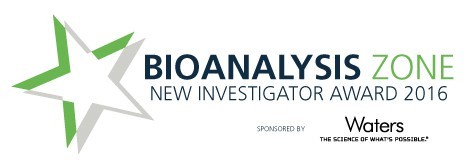2016 New Investigator: Cong (Penny) Bi

 Nominee:
Nominee:
Nominated By:
Supporting Comments:
What made you choose a career in bioanalysis?
I first gained research experience in bioanalysis during my undergraduate studies. As the breadth of my expertise increased, I was amazed by the advancements bioanalytical researchers have achieved in the last decade in areas such as drug discovery and disease diagnosis. I also realized that this field has become a powerful component in the pharmaceutical field and is of great value to human society. Therefore, I was determined to pursue my graduate and postdoctoral studies in bioanalysis with the hope of making my own contributions to this area and in benefitting other researchers and our society through my work.
Describe the main highlights of your bioanalytical research, and its importance to the bioanalytical community.
In my work, high-performance affinity chromatography (HPAC) has been developed and employed for the analysis of drug interactions with AGP, an important serum protein for transporting numerous basic and neutral drugs. I have investigated the development of some novel immobilization methods for preparing affinity microcolumns that contain small amounts of AGP (e.g., from clinical samples or control samples). In addition, I have evaluated the use of these microcolumns with various HPAC-based techniques (e.g., peak profiling, ultrafast affinity extraction, and immunoextraction) to examine the extent and rate of drug interactions with AGP under physiological conditions. Some of these methods were used for measuring free drug fractions in serum or for determining the binding constants for several drugs with AGP in the presence of a large excess and physiological level of human serum albumin (HSA), the most abundant transport protein in humans for many drugs. These new techniques have also been used to study changes in the drug binding properties of AGP that occur in systemic lupus erythematosus and in using samples from individual patients with this disease. This work has demonstrated the potential of using these affinity-based techniques for the rapid analysis of drug-protein interactions in the body.
What is the impact of your work beyond your home laboratory?
Variations have been noted in both the concentration and structure of AGP, as occur in response to events such as trauma, inflammations, cancer and other diseases. These variations may have influence on the drug-binding properties of AGP and, thus, affect the pharmacological effects of drugs that bind to this protein. Both the kinetic and thermodynamic information of drug-AGP binding that I have obtained at therapeutic or physiological levels and by using HPAC allow a better understanding on how changes in AGP can affect the pharmacokinetics and activities of these drugs in patients. This information should be useful in the future in providing physicians with better approaches for selecting treatments (e.g., selecting a drug or its dosage) for patients in disease states where AGP may be altered. The results should also be valuable in applications such as the high-throughput screening of drug candidates and in the analysis of alternative biological interactions.
Describe the most difficult challenge you have encountered in the laboratory and how you overcame it.
One challenge I had was to develop a method for free drug fraction analysis in serum by using AGP microcolumns. AGP can bind numerous basic and neutral drugs with moderate-to-strong affinities; however, many drugs that have significant affinity to AGP also bind to HSA, which is present in serum at a ~30-fold excess level relative to AGP. The presence of two major binding proteins inevitably complicated the estimation of binding constants using the measurement of free drug fractions. To address this issue, a series of equations were derived based on the equilibria for the reversible interactions between a drug and both proteins. Next, several model drugs were selected for testing and developing this approach, with all of these drugs having moderate-to-strong binding to AGP and weak-to-strong binding to HSA. To further validate this method, various therapeutic concentrations of the drugs in serum samples were examined. These results were compared to those found by ultrafiltration, a reference method. The final method enabled the direct measurement of free drug fractions and the estimation of binding constants for drugs with AGP in the presence of HSA, as well as the determination of the relative amount of drug that was bound to each protein.
Describe your role in bioanalytical communities/groups.
During my graduate studies at the University of Nebraska-Lincoln, I have taken a lead role in several bioanalytical research and writing projects that have been related to the development of HPLC methods for personalized medicine and the study of drug-protein interactions by using these methods and AGP microcolumns. I was responsible for managing a number of challenging research and writing projects with specific time constraints, while cooperating with team members to establish synergy and reach common goals. In addition, I have been taking part in a collaboration involving MS to examine the relationship between the structural variations of AGP and its drug-binding properties. I have also mentored several undergraduate students and junior graduate students and have trained them in standard operating procedures for various bioanalytical techniques and instrumentation. Also, I have actively participated in many conferences and research programs for scholarly communications and professional improvement, such as those given by the American Chemical Society, Nebraska Academy of Sciences, and Pittcon conferences. All these experiences have enriched my academic knowledge, improved my critical thinking skills and enhanced my ability to collaborate, which will be of great benefit as I further explore my career in the field of bioanalysis.
Please list up to five of your publications in the field of bioanalysis:
- Bi C, Zheng X, Hage DS. Analysis of free drug fractions in serum by ultrafast affinity extraction and two-dimensional affinity chromatography using α1-acid glycoprotein microcolumns. J. Chromatogr. A 1432, 49–57 (2016).
- Zheng X, Bi C, Brooks M, Hage DS. Analysis of hormone-protein binding in solution by ultrafast affinity extraction: Interactions of testosterone with human serum albumin and sex hormone binding globulin. Anal. Chem. 87, 11187–11194 (2015).
- Bi C, Beeram S, Li Z, Zheng X, Hage DS. Kinetic analysis of drug-protein interactions by affinity chromatography. Drug Discov. Today Technol. 17, 16–21 (2015).
- Bi C, Jackson A, Vargas J et al. Entrapment of alpha1-acid glycoprotein in high-performance affinity columns for drug-protein binding studies. J. Chromatogr. B (2016) (In press).
- Bi C, Matsuda R, Zhang C, Isingizwe Z, Hage DS. Studies of drug binding with alpha1-acid glycoprotein by using on-line immunoextraction and high performance affinity chromatography. Presented at: Pittcon Conference & Expo, Atlanta, GA, USA, 6–10 March 2016.
Please select one publication from above that best highlights your career to date in the field of bioanalysis and provide an explanation for your choice.
Bi C, Zheng X, Hage DS. Analysis of free drug fractions in serum by ultrafast affinity extraction and two-dimensional affinity chromatography using α1-acid glycoprotein microcolumns. J. Chromatogr. A 1432, 49–57 (2016).
A method based on ultrafast affinity extraction and AGP microcolumns was developed for free drug fraction analysis in serum and estimating binding constants for drugs with AGP in the presence of normal physiological levels of HSA. This work was highly complementary to prior free fraction measurements that used HSA microcolumns and significantly expanded the range of pharmaceutical agents that could be examined when determining free drug fractions or drug-protein binding constants by ultrafast affinity extraction. This approach should be a valuable tool in areas such as personalized medicine and the high-throughput analysis of drug–protein binding in biological samples.
Find out more about this year’s New Investigator Award, the prize, the judging panel and the rest of our nominees.

